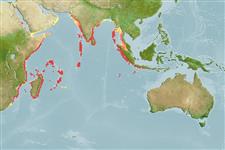Common names from other countries
>
Mulliformes (Goatfishes) >
Mullidae (Goatfishes)
Etymology: Parupeneus: Latin, parum, parvum = small + Peneus, the name of a river.
More on author: Lacepède.
Environment: milieu / climate zone / depth range / distribution range
экология
морской ассоциированный с рифами; пределы глубины 0 - 80 m (Ref. 1602). Tropical; 24°N - 33°S, 28°E - 112°E
Indian Ocean: Oman and East Africa south to South Africa and east to Christmas Island and Java, Indonesia.
Included in the Parupeneus trifasciatus complex are: Parupeneus trifasciatus from the Indian Ocean; Parupeneus crassilabris from eastern Indian Ocean and the western Pacific, east to Fiji, Tonga, and the Caroline Islands; and Parupeneus insularis from the more eastern islands of Oceania.
Size / Вес / Возраст
Maturity: Lm ? range ? - ? cm
Max length : 35.0 cm TL самец/пол неопределен; (Ref. 30573); common length : 27.0 cm TL самец/пол неопределен; (Ref. 30573); наибольший вес (опубликованные данные): 656.00 g (Ref. 125599)
колючие лучи спинного плавника (общее число) : 8; членистые (мягкие) лучи спинного плавника (общее число) : 9; колючие лучи анального плавника: 1; членистые (мягкие) лучи анального плавника: 7.
This occasionally schooling species inhabits lagoon and seaward reefs: juveniles on reef flats, adults tend to occur around rocky or coralline areas of high vertical relief. Feeds on crustaceans at daytime and on fishes and crab larvae at night. Also feeds on worms (Ref. 6113). Occurs in 3 color forms. The Indian Ocean form has 2 sharply defined wedge-shaped bars become narrower and sometimes end on the belly. The Indo-Australian form has 3 very distinct dark patches and rows of yellow spots on the sides. The Pacific Plate form has 2 wide bars that extend to the belly (Ref. 37816). Minimum depth reported taken from Ref. 128797.
Life cycle and mating behavior
Maturities | размножение | Spawnings | Egg(s) | Fecundities | личинки
Randall, J.E. and R.F. Myers, 2002. Parupeneus insularis, a new central pacific species of goatfish (Perciformes:Mullidae) of the P. trifasciatus complex. Zool. Stud. 41(4):431-440. (Ref. 45589)
Статус Красного Списка МСОП (Ref. 130435)
CITES (Ref. 128078)
Not Evaluated
Угроза для людей
Harmless
Использование человеком
рыболовство: коммерческий
дополнительная информация
инструменты
Специальные отчеты
Скачать в формате XML
ресурсы в Интернет
Estimates based on models
Preferred temperature (Ref.
115969): 23.6 - 29, mean 27.8 (based on 1364 cells).
Phylogenetic diversity index (Ref.
82804): PD
50 = 0.5000 [Uniqueness, from 0.5 = low to 2.0 = high].
Bayesian length-weight: a=0.00813 (0.00535 - 0.01235), b=3.18 (3.06 - 3.30), in cm Total Length, based on LWR estimates for this species & Genus-body shape (Ref.
93245).
Trophic level (Ref.
69278): 3.5 ±0.50 se; based on food items.
устойчивость к внешним воздействиям (Ref.
120179): средний (среднего размера), минимальное время удвоения популяции 1.4-4.4 года (Preliminary K or Fecundity.).
Fishing Vulnerability (Ref.
59153): Low vulnerability (25 of 100).
